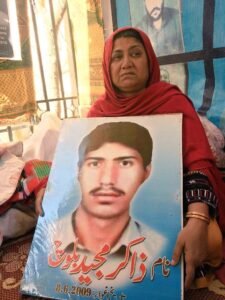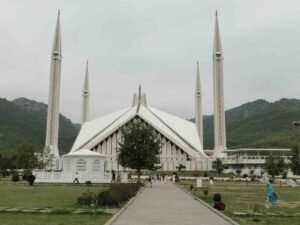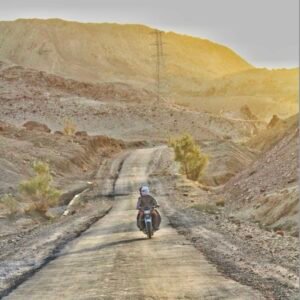The Twin Threats: Tehrik-e-Taliban Pakistan and Tehrik-e-Taliban Afghanistan’s Strain on Pakistan’s National Security

A reported Taliban suicide bomber in Kabul celebrating the Taliban's second victory anniversary in August 2023. The fighter is seen holding an AK-47, artificial roses, a small flag bearing the inscription "Islamic Emirate of Afghanistan," and the declaration "there is no God but Allah and Mohammad ص is the Messenger of Allah." The same message is inscribed on the wall in the background, which is part of the U.S. Embassy in Kabul. Photo: @AADIL
By Amit Kumar
The heightened attacks by Tehrik-e-Taliban Pakistan (TTP) against the Pakistani government following the Taliban’s assumption of power in August 2021 in Afghanistan are in the limelight. Empirical data from the Islamabad Research Center reveals a significant surge of 51% in attacks within Pakistan since the Taliban’s rise to power, thereby underscoring TTP’s mounting challenge to the state’s authority. Originating in 2007, TTP’s primary aim has been to establish territorial autonomy in Pakistan’s tribal areas and enforce Sharia law nationwide, with its influence predominantly concentrated in Khyber Pakhtunkhwa and Balochistan. Last month’s suicide attack in Islamabad is a notable manifestation of TTP’s ability to strategically target the heart of the capital, showcasing its tactical sophistication.
Over the past two decades, Pakistan has strategically supported Tehrik Taliban Afghanistan (TTA) and mistakenly anticipated reciprocated government backing upon their ascent to power. Another flawed assumption by the Pakistani government was the prospect of cooperation between the Taliban and TTP. Contrary to expectations, the Afghan Taliban facilitated dialogues between the Pakistani government and TTP, moderated by Sirajuddin Haqqani, which ultimately failed to yield desired results. Consequently, the relationship between the Taliban and Pakistan became unexpectedly strained, with the Taliban non-compliant with Pakistan’s post-power demands. Rather than being isolated, TTP garnered significant strength through Taliban support, enabling large-scale attacks within Pakistan.
This investigation scrutinizes the Afghan Taliban’s reluctance to suppress TTP, despite the repercussions of strained relations with Pakistan, while also highlighting the Pakistani military’s shortcomings in countering TTP’s activities. Through five key axes, this study explores the interconnections between TTP and TTA and the factors contributing to the Pakistani army’s lack of effective cooperative operations against the TTP. By engaging with these intricate dynamics, this analysis contributes to a nuanced understanding of the evolving political landscape in the region.
A Sense of Self-Confidence
In the aftermath of the Taliban’s overthrow of the Afghan government in 2021, various Islamist groups, notably the Tehrik-e-Taliban Pakistan (TTP), gained significant empowerment. Drawing inspiration from the protracted guerrilla warfare waged by the Afghan Taliban against American and NATO forces, the TTP has adopted a similar strategy in its conflict with the Pakistani government.
Comprising predominantly of students from religious schools, TTP fighters perceive their struggle against the Pakistani government as a sacred endeavor. Witnessing the establishment of a Sharia-based system by their ideological brethren in Afghanistan, they have been emboldened to envision a second iteration of the Taliban regime within Pakistan. This heightened self-confidence has fueled the TTP’s determination to wage a prolonged war of attrition against the Pakistani government. The TTP’s leadership has openly declared its readiness to engage in protracted hostilities, asserting its possession of ample ammunition, weapons, and human resources to sustain such a conflict for decades.
Geostrategic Location
Afghanistan and Pakistan share an extensive border spanning over 1600 miles, characterized by rugged mountainous terrain, making it challenging to control migration flows. This porous border has emerged as a strategic advantage for the TTP. Following attacks, TTP forces can conveniently seek refuge by crossing into Afghanistan, where they have successfully adopted military tactics similar to those employed by the Afghan Taliban. In the wake of the Taliban’s rise to power in Afghanistan, many clashes between Pakistan Rangers and Taliban forces have been recorded in various border regions, indicating heightened tension and mutual mistrust between both sides.
The Pakistani authorities assert that the Afghan Taliban has provided a haven for the TTP, with the latter’s leadership reportedly residing in Afghanistan. This has posed formidable challenges for the Pakistan Army in their efforts to suppress TTP bases across the border. Conversely, the TTP has refrained from establishing specific bases within Pakistan, opting instead for agile “fight and flight” tactics.
Previously, Islamabad’s military strategists believed that facilitating the ascent of an Islamist government in Kabul, sympathetic to Islamabad and in opposition to New Delhi, would secure Pakistan’s strategic depth in Afghanistan. However, the current reality reveals a reversal of fortunes, wherein the TTP has transformed this strategic depth into a formidable strategic obstacle against the government of Pakistan, leveraging it to its advantage.
Access to Modern Weapons
The TTP’s capacity to confront and challenge Pakistan’s national security has been significantly bolstered by its acquisition of modern and advanced weaponry abandoned by American and NATO forces in Afghanistan. The Taliban facilitated the transfer of these weapons to the TTP, which are readily accessible through the black market in Afghanistan. The TTP leadership recently affirmed on CNN that they possess a substantial arsenal of weaponry and ammunition to sustain their resistance against the Pakistani government for decades.
Pakistani media reports indicate that TTP fighters have procured cutting-edge M4 and M16 service weapons, night vision and American sniper equipment. These sophisticated armaments were originally provided to the former commandos of the Afghan army by the United States. These weapons are wielded by the TTP fighters in their confrontation with the Pakistani military.
Despite Pakistan’s army being one of the largest and most formidable in the region, both in quantity and quality, the TTP’s possession of modern weaponry has exposed vulnerabilities within the armed forces. While the Pakistan army boasts formidable training and possesses nuclear capabilities, the guerrilla warfare tactics adopted by the TTP, coupled with the deployment of advanced NATO-provided weaponry, pose significant risks to the army’s security and operational effectiveness. This confluence of factors accentuates the potential for dangerous repercussions on Pakistan’s military and overall security landscape.
Deobandi Islam
The inception of the Deobandi Religious School (Madrassa) stemmed from a reactionary response to British colonialism in the Indian subcontinent, wherein it exhorted Muslims to undertake jihad and rise against British rule. The Deobandi school is characterized by enmity towards the West and its allies, embodying elements of jihadism and xenophobia, thus unifying the religious ideology followed by the Afghan Taliban and the TTP. However, it is noteworthy that Indian Deobandis hold distinct perspectives compared to their Pakistani counterparts.
During the commencement of the Afghan Jihad, Deobandi teachings were interwoven with Wahhabism, giving rise to a blend of these two ideologies adhered to by the Taliban and TTP. Notably, both groups embrace this amalgamation as a foundational doctrine.
Beyond the student population of Deobandi schools, the TTP’s middle and lower ranks encompass individuals with divergent backgrounds. Among these ranks, one can find arms and drug smugglers, fugitives from the law, and those who reject government authority. Akin to the Afghan Taliban, the TTP has employed a similar recruitment strategy over the past two decades, attracting jihadists and criminals into their ranks.
Ethnicity and kinship
The salience of ethnicity and kinship in the affiliation between the Taliban and TTP demands careful consideration. Substantial cultural, ethnic, and familial linkages underpin the relationship between these groups. Stanford University research reveals that most TTP fighters, including its leadership, hail from Pakistani Pashtun backgrounds. On the Afghan side, a similar trend is observed within the Taliban, wherein a considerable proportion, including cabinet members, share cultural and ethnic connections with the Pakistani Taliban. Over the past two decades, numerous intermarriages between members of the TTP and Afghan Taliban have further solidified the ties between these entities, fostering a strengthened bond.
Integral to Pashtunwali culture is the emphasis on friendship and hospitality, a crucial custom in enabling TTP members to find secure refuge among their comrades in Afghanistan. During this period, the TTP has been receptive to the Afghan Taliban across the Durand Line, and reciprocally, the Taliban, now in governance, feels compelled to extend protection and hospitality to their brethren from similar ethnic, cultural, and Deobandi backgrounds situated on the other side of the border. This cultural ethos has engendered a mutual obligation of support and sustenance, reinforcing the symbiotic relationship between the two groups within a complex network of shared identities and customs.
Conclusion
Delineating a clear demarcation between the Afghan Taliban and the Pakistani Taliban proves highly intricate, at times even unattainable. Both entities have arisen within comparable intellectual and religious environments, sharing congruent convictions concerning women’s rights, governance, the implementation of Sharia law, and overarching worldviews. Moreover, they exhibit cultural, ethnic, and geographic affinities, further intertwining their identities. Consequently, the government of Pakistan encounters significant difficulty in countering the TTP, as the similarities between the two groups exacerbate the challenge.
The prevailing historical record of Islamist groups attests that the ascendancy of an extreme Islamist faction in a country tends to foster and bolster other terrorist and Islamist entities, considering such support a religious and sacred obligation. In this context, the TTP has transcended being a mere propagandist menace for Pakistan and has metamorphosed into a formidable national security predicament necessitating resolute action.
Given the current governance of the Taliban in Afghanistan, the TTP stands to benefit and leverage the safe strategic haven provided. Thus, the ideological alignment and safe haven dynamics confluence compel Pakistan to confront the TTP as a pressing security imperative, necessitating astute measures to address this potent challenge.
Author:
Amit Kumar is a doctoral candidate specializing in China-Afghanistan relations at the Birla Institute of Technology and Science, Pilani, India. In addition, he is an Adjunct Researcher at The MirYam Institute in New York. He is also an Associate Editor for The Defence Horizon Journal in Austria.
Note: The contents of the article are of sole responsibility of the author. Afghan Diaspora Network will not be responsible for any inaccurate or incorrect statement in the articles.











